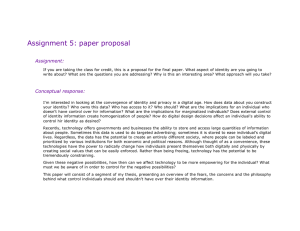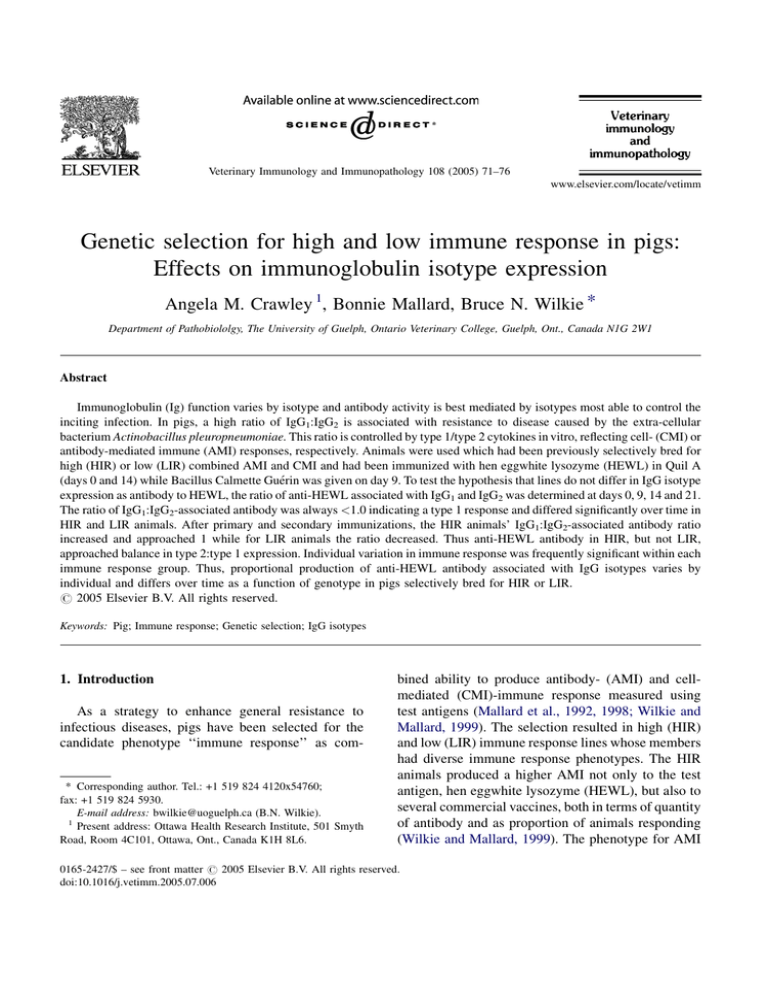
Veterinary Immunology and Immunopathology 108 (2005) 71–76
www.elsevier.com/locate/vetimm
Genetic selection for high and low immune response in pigs:
Effects on immunoglobulin isotype expression
Angela M. Crawley 1, Bonnie Mallard, Bruce N. Wilkie *
Department of Pathobiololgy, The University of Guelph, Ontario Veterinary College, Guelph, Ont., Canada N1G 2W1
Abstract
Immunoglobulin (Ig) function varies by isotype and antibody activity is best mediated by isotypes most able to control the
inciting infection. In pigs, a high ratio of IgG1:IgG2 is associated with resistance to disease caused by the extra-cellular
bacterium Actinobacillus pleuropneumoniae. This ratio is controlled by type 1/type 2 cytokines in vitro, reflecting cell- (CMI) or
antibody-mediated immune (AMI) responses, respectively. Animals were used which had been previously selectively bred for
high (HIR) or low (LIR) combined AMI and CMI and had been immunized with hen eggwhite lysozyme (HEWL) in Quil A
(days 0 and 14) while Bacillus Calmette Guérin was given on day 9. To test the hypothesis that lines do not differ in IgG isotype
expression as antibody to HEWL, the ratio of anti-HEWL associated with IgG1 and IgG2 was determined at days 0, 9, 14 and 21.
The ratio of IgG1:IgG2-associated antibody was always <1.0 indicating a type 1 response and differed significantly over time in
HIR and LIR animals. After primary and secondary immunizations, the HIR animals’ IgG1:IgG2-associated antibody ratio
increased and approached 1 while for LIR animals the ratio decreased. Thus anti-HEWL antibody in HIR, but not LIR,
approached balance in type 2:type 1 expression. Individual variation in immune response was frequently significant within each
immune response group. Thus, proportional production of anti-HEWL antibody associated with IgG isotypes varies by
individual and differs over time as a function of genotype in pigs selectively bred for HIR or LIR.
# 2005 Elsevier B.V. All rights reserved.
Keywords: Pig; Immune response; Genetic selection; IgG isotypes
1. Introduction
As a strategy to enhance general resistance to
infectious diseases, pigs have been selected for the
candidate phenotype ‘‘immune response’’ as com* Corresponding author. Tel.: +1 519 824 4120x54760;
fax: +1 519 824 5930.
E-mail address: bwilkie@uoguelph.ca (B.N. Wilkie).
1
Present address: Ottawa Health Research Institute, 501 Smyth
Road, Room 4C101, Ottawa, Ont., Canada K1H 8L6.
bined ability to produce antibody- (AMI) and cellmediated (CMI)-immune response measured using
test antigens (Mallard et al., 1992, 1998; Wilkie and
Mallard, 1999). The selection resulted in high (HIR)
and low (LIR) immune response lines whose members
had diverse immune response phenotypes. The HIR
animals produced a higher AMI not only to the test
antigen, hen eggwhite lysozyme (HEWL), but also to
several commercial vaccines, both in terms of quantity
of antibody and as proportion of animals responding
(Wilkie and Mallard, 1999). The phenotype for AMI
0165-2427/$ – see front matter # 2005 Elsevier B.V. All rights reserved.
doi:10.1016/j.vetimm.2005.07.006
72
A.M. Crawley et al. / Veterinary Immunology and Immunopathology 108 (2005) 71–76
used in the selection was amount of serum anti-HEWL
antibodies (Ab) measured by enzyme-linked immunsorbent assay (ELISA) on day 21 of a protocol
involving primary (day 0) and secondary (day 14)
immunizations. The ELISA used anti-pig IgG (H + L)
as secondary Ab, hence was not IgG isotype-specific
(Mallard et al., 1992). Although there was no
deliberate attempt to include a measurement of Ab
avidity in the selection, the lines differed significantly
and ranked in descending order of anti-HEWL avidity,
HIR > Control (unselected) > LIR (Appleyard et al.,
1992). Given that the method of selection for breeding
gave equal weighting to AMI and CMI and the method
of quantifying Ab was not designed to discriminate by
IgG isotype (Mallard et al., 1992), it was assumed that
the lines would have balanced utilization of the only
two IgG isotypes identified in pigs as antigenic
proteins, namely IgG1 and IgG2 (Bokhout et al., 1986;
Crawley and Wilkie, 2003).
Differential Ig isotype expression permits diverse
isotype-related functions, such as complement activation and binding to Fc receptors on phagocytic cells, to
appropriately respond to antigenic stimuli (Miletic
and Frank, 1995; Miletic et al., 1996). Typically,
complement and phagocytosis-activating Ig isotypes
are induced by Th1 cytokines. Human IgM, IgG1,
IgG3 and murine IgG1, IgG2a, IgG2b are effective
activators of complement while human IgG2 is less so.
Human IgG4, IgA, IgE and murine IgG1 do not
activate complement (Miletic and Frank, 1995;
Miletic et al., 1996). In cattle, the IgG2b allotype
activates complement more efficiently than allotype
IgG2a or IgG1(McGuire et al., 1979; Bastida-Corcuera
et al., 1999). In horses infected with intestinal
nematodes, there is a strong IgG(T) response (Patton
et al., 1978; Proudman and Trees, 1996) while IgGa is
the predominant isotype produced in response to
Streptococcus equi (Sheoran et al., 1997). Horses
immunized with Rhodococcus equi antigens in
aluminium hydroxide produced an IgGb and
IgG(T)-biased response (Prescott et al., 1997).
Aluminium hydroxide induces type 2-biased immune
response in mice, humans and other species (Brewer
et al., 1999). Thus, equine IgG(T) and IgGb are
putative type 2 isotypes while IgGa is type 1. Pig IgG1
and IgG2 are differentially expressed under type 2 and
type 1 cytokine control, respectively (Crawley et al.,
2003) and IgG2 is significantly better than IgG1 in
activating guinea pig complement (Crawley and
Wilkie, 2003) hence pig IgG1 and IgG2 are assumed
to be type 2 and type 1 isotypes, respectively. This is
consistent with the observation that resistance to
Actinobacillus pleuropnuemoniae, an extracellular
toxigenic bacterium, is significantly correlated with
high ratios of IgG1:IgG2 associated toxin neutralizing
antibodies (Furesz et al., 1998). Similarly, resistance
to the nematode Ascaris suum is correlated with a high
ratio of IgG1:IgG2 (Frontera et al., 2003). The
pathotypes of each of these infectious diseases would
suggest that type 2 isotypes would be protective.
Given the relevance of antibody-IgG isotype
associations to resistance to infectious diseases, the
hypothesis that Ig isotype association of anti-HEWL
Ab did not differ by immune response selection line
was tested here.
2. Materials and methods
2.1. Animals and experimental design
The study utilized sera stored at 208 C from pigs
of the eighth generation of selective breeding based on
combined estimated breeding values (EBV) for HIR
and LIR of AMI and CMI as previously described
(Mallard et al., 1992). Control pigs (C) were not
selected. To determine induced immune response
phenotype, animals were immunized intramuscularly
on day 0 and day 14 with HEWL (10 mg) and 1 mg of
Quil A (Cedarlane Laboratories Ltd., Hornby, Ont.).
One adult dose of Bacillus Calmette-Guérin (BCG,
Connaught Labs, Willowdale, Ontario) was injected
intradermally on day 9. Cutaneous delayed-type
hypersensitivty (DTH) to purified protein derivative
of tuberculin (PPD, Connaught Labs) and ELISAquantified day 21 IgG (H + L)-related anti-HEWL
antibody were used as specific quantitative indicators
of CMI and AMI, respectively. In determining the
combined EBVs used in selective breeding decisions
to derive the HIR and LIR lines, equal weighting was
given to EBVs for AMI and CMI consistent with the
objective of deriving HIR animals with increased
ability to make both AMI and CMI responses. Nonspecific estimators of T-lymphocyte (Concanavalin A
(con A)-induced blood lymphocyte blastogenesis) and
B-lymphocyte (serum IgG concentration) activity
A.M. Crawley et al. / Veterinary Immunology and Immunopathology 108 (2005) 71–76
were also used to calculate EBVs included with equal
weighting in the combined EBV. In the present
experiments, anti-HEWL antibody-immunoglobulin
isotype associations were determined by ELISA in
sera from retro-orbital sinus blood collected on days 0,
9, 14 and 21. Sera from each of six animals of each line
were randomly selected without regard for gender and
used to determine anti-HEWL Ab activity in association with IgM, IgG1 and IgG2.
2.2. Anti-HEWL IgG isotype-specific ELISA
Enzyme immunoassays were used to detect
HEWL-specific porcine IgM, IgG1 and IgG2 antibodies. Flat bottomed, high-binding, polystyrene 96well plates (Dynex Technologies Inc., Immulon 2HB,
VWR International, Mississauga, Ont.) were coated
with 100 ml/well of HEWL (1 mg/ml) in 0.05 M
carbonate bicarbonate buffer pH 9.6 by incubating for
20 h at 48 C. Plates were washed three times
(Automatic Plate Washer, ELX405, Bio-Tek Instruments Inc., Winooski, VT, USA) with 200 ml/well of
PBS + 0.5% Tween-20 (PBST) prior to blocking with
100 ml/well of 1% BSA in PBST for 1 h at 378 C.
Plates were washed and serum (1:10, 100 ml/well) was
added. Pooled day 21 and day 0 sera were used as
positive and negative controls, respectively. Platenegative controls were PBST only. Samples were
tested in quadruplicate and incubated for 1 h at 378 C.
Monoclonal anti-swine immunoglobulins (from Dr. K.
Nielsen, Animal Disease Research Institute, Nepean,
Ont.) were biotinylated as described previously
(Crawley et al., 2003). Plates were washed as before
and 100 ml/well of biotinylated mouse anti-swine
IgG1 or IgG2 Abs were added and incubated for 1 h at
378 C. Plates were washed and bound anti-Igs detected
by incubating with 100 ml/well of avidin-alkaline
phosphatase (10 mg/ml) (Vector Laboratories Inc.,
Burlington, Ont.) for 1 h at 378 C. Plates were washed
again and incubated for 45 min at 378 C with 100 ml/
well of the chromogenic substrate (disodium nitrophenyl phosphate, Sigma–Aldrich Inc.). Reaction
product and background optical densities (OD) were
quantified at 405nm and 630nm, respectively (96-well
plate reader, EL808, Bio-Tek Instruments Inc.). For
each assay plate, the relative Ig isotype-related Ab
activity of individual animals’ sera were expressed in
relation to the activity of the positive control as
73
follows: %OD of positive control = [(sample OD/
(positive control OD negative control OD)] 100.
2.3. Statistical analysis
All data were plotted using Graph-Pad Prism 4.0
software (GraphPad Software Inc., San Diego, CA,
USA). Antibody isotype responses and individual and
litter effects were evaluated by analysis of variance
using the general linear model (GLM) procedure of
Minitab Statistical Software Release 13 (Minitab Inc.,
State College, PA, USA). The statistical model was:
yijk = m + animali + dayj + eijk where yijk is the Ig
isotype-associated Ab response by animali on dayj, m
the population mean of response, animali the effect of
animal i where i = 1–18 (3 pigs/line), dayj the effect of
time where j = day 0, 9, 14 or 21 and eijk is the random
error term. Significance was reported at p 0.05.
3. Results and discussion
The available data indicate rejection of the hypothesis that breeding lines of pigs selected for high, low and
control (unselected) combined CMI and AMI response
do not differ in bias of anti-HEWL serum antibody
association with the types 1 and 2 IgG isotypes IgG2 and
IgG1, respectively. Pigs of all lines had IgG1:IgG2
ratios < 1.0 (Table 1), indicating type 1 immune
response (Crawley and Wilkie, 2003; Crawley et al.,
2003). This was unexpected in HIR and LIR pigs given
the equivalent weighting of the EBVs for AMI and CMI
as well as for corresponding non-specific indicators
(serum IgG concentration and con A-induced lymphocyte blastogenesis) in the combined EBVs used to select
individuals of HIR and LIR for breeding. That the
unselected C pigs also produced Ab with a preponderance of IgG2 may indicate that the immunization
protocol induces this bias regardless of genetic
predisposition to HIR or LIR.
All breeding lines had primary IgM-associated
HEWL Abs on day 9 which decreased by day 14
(Fig. 1). Secondary IgM responses were detected only
in HIR and Control lines, in each case, the mean being
increased by a single outlying response. Control line
pigs increased IgG2-associated anti-HEWL Abs on
days 9 and 14 while IgG1 was increased only on day 14
(Fig. 1). Low line animals produced a primary IgG2
74
A.M. Crawley et al. / Veterinary Immunology and Immunopathology 108 (2005) 71–76
Table 1
Least squares means of serum anti-hen eggwhite lysozyme (HEWL) IgG1:IgG2 ratios of pigs selectively bred for high (HIR) or low (LIR
combined antibody and cell-mediated immune response or bred without selection (C)
Daya
HIR
C
LIR
0
9
LS mean
LS mean b
Animal effectc
LS mean
14
Animal effect
LS mean
21
Animal effect
0.485
0.451
0.560
0.230 (0.001)
0.258 (0.000)
0.176 (0.000)
0.385
0.034
0.031
0.350 (0.000)
0.305 (0.050)
0.462 (0.000)
0.003
0.761
0.887
0.867 (0.000)
0.441 (0.195)
0.189 (0.000)
0.030
0.026
0.816
a
Day refers to time within the immunization schedule in which animals received by intramuscular injection on days 0 and 14, 10 mg of
HEWL and 1mg of Quil A while on day 9 one adult dose of Bacillus Calmette Guérin vaccine was given intradermally.
b
LS means of group ratios with value of p in parentheses for comparisons with previous time.
c
Value of p for the effect of animal within the group.
response (day 9) followed by an IgG1 response on day
14 ( p 0.001), then significantly increased IgG2 by
day 21 ( p 0.001) whereas IgG1 decreased
( p = 0.037). In contrast, HIR animals increased the
production of IgG2 on days 9 and 14 and increased IgG1
on days 14 and day 21 ( p 0.001). The mean HIR, LIR
and Control line IgG1:IgG2 ratios were ranked in
decreasing order of HIR > Control > LIR on both days
14 and 21 ( p 0.05) (Table 1). Individual variation in
Ab isotype responses was significant within the
breeding lines ( p 0.05) with obvious outliers, some
of which had opposite responses to the other individuals
in the group (Fig. 1 and Table 1).
Hence, in all three breeding groups IgM participated in primary immune response as did IgG2, while
IgG1, a putative type 2 isotype, did not increase until
day 14 in all three breeding groups (Fig. 1). The most
remarkable observation was the overall difference in
IgG1:IgG2 ratios of the HIR and LIR animals’ serum
anti-HEWL antibody on day 21. At that time, five of
six HIR animals had significantly increased use of
IgG1 while expression of IgG2 had declined in five of
six (Fig. 1 and Table 1) although the change was not
statistically significant. In contrast, the LIR animals on
day 21 significantly reduced use of IgG1 and increased
Ab bias to IgG2 (Fig. 1 and Table 1). The C animals did
not alter bias of Ab to IgG1 or IgG2 between days 14
and 21 (Fig. 1 and Table 1).
It is not known why the selection as conducted
appeared to introduce divergent IgG isotype bias in HIR
and LIR animals at day 21, the day on which Ab
response was measured to obtain the values used in
calculating the EBV used in selection. Since the
selection criteria utilized Ab amounts detected by
ELISA using anti-IgG specific for both H and L chains
(Mallard et al., 1992), it was assumed that this
measurement would be free of IgG isotype bias but
this may not be the case. If this reagent preferentially
detected IgG1, the HIR animals may have been selected
to express this bias and hence a possible type 2 immune
response. The immunizing antigen, HEWL may have
been expected to induce type 2 bias of Ab since it has
been reported to behave as a type 2 stimulus on the basis
of cytokine message detected in co-cultures of
autologous pig blood monocyte-derived dendritic cells
and T-cells (Raymond and Wilkie, 2004). Overall
however, the IgG1:IgG2 ratio of anti-HEWL in HIR pigs
at day 21 more closely approached 1.0 than that of either
C or LIR pigs (Table 1) suggesting a nearly neutral type
2:type1 ratio, a theoretically desirable outcome consistent with the objective of selectively breeding for
enhanced immune response and resistance to infectious
disease generally, regardless of pathotype.
While immune response breeding line-related
effects on IgG isotype bias in pigs are confirmed
here, environmental effects on pig immunoglobulin
isotype switching are indicated by reports of IgG1 and
IgG2 utilization in primary and secondary responses to
immunization with human serum albumin in incomplete Freund’s adjuvant in that IgG1 was used first
(Van der Stede et al., 2001), in contrast to the early
IgG2 bias observed here (Fig. 1). Similarly, it has been
reported that in response to classic swine fever virus,
the time course of IgG1 and IgG2 antibody expression
is a function of both viral state (virulent versus
attenuated) and route of exposure (intranasal versus
intramuscular) (Piriou et al., 2003). Hence IgG isotype
bias is an important variable worthy of investigation in
A.M. Crawley et al. / Veterinary Immunology and Immunopathology 108 (2005) 71–76
75
Fig. 1. Immunoglobulin isotype relatedness of serum anti-hen eggwhite lysozyme (HEWL) antibody induced in pigs selectively bred for high
(HIR) or low (LIR) immune response phenotypes or of control (C) pigs bred without selection. Eighteen 6-week-old pigs (day 0), including six
animals from each of HIR, C and LIR immune response lines, were immunized with HEWL in Quil A (day 0), then Bacillus Calmette-Guérin
(BCG) (day 9) and HEWL in Quil A (day 14). Sera were obtained on days 0, 9, 14 and 21 and IgM, IgG1 and IgG2-related anti-HEWL responses
were measured by ELISA. Data are represented as least squares means of percentage change of optical density (OD) compared to the positive and
negative controls using the formula: % change OD = [(sample OD/(positive control OD negative control OD)] 100. Significance ( p 0.05)
of difference between time points was tested using the general linear model (GLM) analysis of variance and is indicated by ‘‘*’’ with respect to
immediately preceding time points. Group means are represented by horizontal lines. Responses in which there were significant animal effects,
as determined by GLM, are indicated by ‘‘v’’. Individual animals in each treatment group are designated by the symbols: (1) &, (2) ~, (3) !, (4)
^, (5) *, (6) &.
the context of genetic and environmental interventions
intended to enhance resistance to infectious disease.
Research Council of Canada. Dr. K. Nielsen is thanked
for providing monoclonal antibodies and Drs. D.
Haydon and W. Sears for assistance with data analysis.
Acknowledgements
References
This research was supported by a grant to B.N.
Wilkie from the Natural Sciences and Engineering
Appleyard, G., Wilkie, B.N., Kennedy, B.W., Mallard, B.A., 1992.
Antibody avidity in Yorkshire pigs of high and low
76
A.M. Crawley et al. / Veterinary Immunology and Immunopathology 108 (2005) 71–76
immune response groups. Vet. Immunol. Immunopathol. 31,
229–240.
Bastida-Corcuera, F.D., Butler, J.E., Yahiro, S., Corbeil, L.B., 1999.
Differential complement activation by bovine IgG2 allotypes.
Vet. Immmunol. Immunopathol. 71, 115–123.
Bokhout, B.A., van Asten-Noordijk, J.J.L., Stok, W., 1986. Porcine
IgG. Isolation of two IgG-subclasses and anti-IgG class- and
subclass-specific antibodies. Mol. Immunol. 23, 675–683.
Brewer, J.M., Conacher, C.A., Hunter, M., Mohrs, F., Alexander, J.,
1999. Aluminium hydroxide adjuvant initiates strong antigen
specific responses in the absence of Il-4 or Il-13-mediated
signalling. J. Immunol. 163, 6448–6454.
Crawley, A., Wilkie, B.N., 2003. Porcine Ig isotypes: function and
molecular characteristics. Vaccine 21, 291–2922.
Crawley, A., Raymond, C.R., Wilkie, B.N., 2003. Control of immunoglobulin isotype production by porcine B-cells cultured with
cytokines. Vet. Immunol. Immunopathol. 91, 141–154.
Furesz, S.E., Wilkie, B.N., Mallard, B.A., Rosendal, S., MacInnes,
J.L., 1998. Anti-haemolysin IgG1 to IgG2 ratios correlate with
haemolysin neutralization titres and lung lesion scores in Actinobacillus pleuropnuemoniae infected pigs. Vaccine 16, 1971–1975.
Frontera, E., Carron, A., Serrano, F.J., Roepstorff, A., Reina, D.,
Navarette, I., 2003. Specific systemic IgG1, IgG2 and IgM
responses in pigs immunized with infective eggs or selected
antigens of Ascaris suum. Parasitology 127, 291–298.
Mallard, B.A., Wilkie, B.N., Kennedy, B.W., Quinton, M., 1992.
Use of estimated breeding values in a selection index to breed
Yorkshire pigs for high and low immune and innate resistance
factors. Anim. Biotech. 3, 257–280.
Mallard, B.A., Wilkie, B.N., Kennedy, B.W., Gibson, J., Quinton,
M., 1998. Immune responsiveness in swine: eight generations of
selection for high and low immune response in Yorkshire pigs.
In: Proceedings of the Sixth World Congress on Genetics
Applied to Livestock Production, Armidale, pp. 1–8.
McGuire, T.C., Musoke, A.J., Kurtti, T., 1979. Functional properties
of bovine IgG1 and IgG2: interaction with complement, macrophages, neutrophils and skin. Immunology 38, 249–256.
Miletic, V.D., Frank, M.M., 1995. Complement-immunoglobulin
interactions. Curr. Opin. Immunol. 7, 41–47.
Miletic, V.D., Hester, C.G., Frank, M.M., 1996. Regulation of
complement activity by immunoglobulin isotype on C4 uptake
on antibody-sensitized sheep erythrocytes and solid phase
immune complexes. J. Immunol. 156, 749–757.
Patton, S., Mock, R.E., Drudge, J.H., Morgan, D., 1978. Increase in
immunoglobulin T in ponies as a response to experimental
infection with the nematode Stongylus vulgaris. Am. J. Vet.
Res. 39, 19–24.
Piriou, L., Chevallier, S., Hutet, E., Charley, B., Le Potier, M.F.,
Albina, E., 2003. Humoral and cell-mediated immune responses
of d/d histocompatible pigs against classical swine fever (CSF)
virus. Vet. Res. 34, 389–404.
Prescott, J.F., Nicholson, V.M., Patterson, M.C., Melerio, M.C.Z.,
Caterino de Araujo, A., Yaeger, J.E., Holmes, M.A., 1997. Use
of Rhodococcus equi virulence-associated protein for immunization of foals against Rhodococcus equi pneumonia. Am. J. Vet.
Res. 58, 356–359.
Proudman, C.J., Trees, A.J., 1996. Correlation of antigen specific
IgG and IgG(T) responses with Anoplocephala perfoliata
infection intensity in the horse. Parasite Immunol. 18, 499–
506.
Raymond, C.R., Wilkie, B.N., 2004. Th-1/Th-2 type cytokine
profiles of pig T-cells cultured with antigen-treated monocytederived dendritic cells. Vaccine 22, 1016–1023.
Sheoran, A.S., Sponseller, B.T., Holmes, M.A., Timoney, J.F., 1997.
Serum and mucosal antibody isotype responses to M-like protein
(SeM) of Streptpococcus equi in convalescent and vaccinated
horses. Vet. Immunol. Immunopathol. 59, 239–251.
Van der Stede, Y., Cox, E., Van den Broek, W., Goddeeris, B.M.,
2001. Enhanced induction of the IgA response in pigs by
calcitrol after intramuscular immunization. Vaccine 19, 1870–
1878.
Wilkie, B.N., Mallard, B.A., 1999. Selection for high immune
response: an alternative approach to animal health
maintenance? Vet. Immunol. Immunopathol. 72, 231–235.

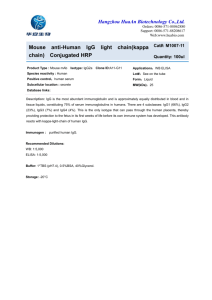
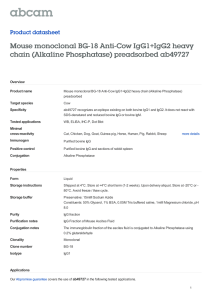
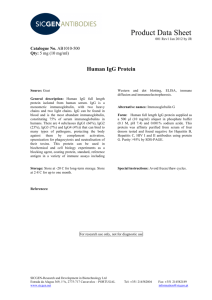
![Mouse IgG1, kappa monoclonal [15H6] (Cy5®) - Isotype](http://s2.studylib.net/store/data/012475137_1-95c3dd04bb0a6572f6fa7502d4eb6660-300x300.png)
